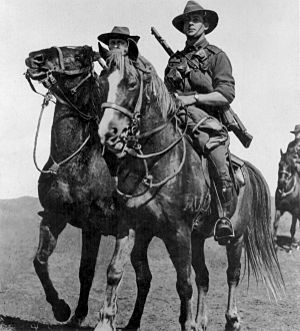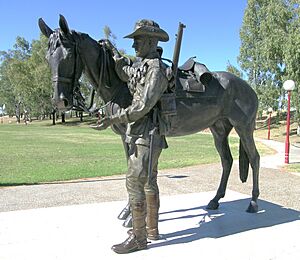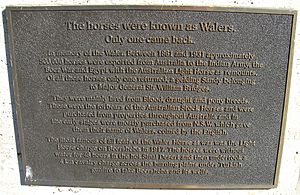Waler facts for kids

Australian Light Horse Walers
|
|
| Country of origin | Australia |
|---|---|
| Horse (Equus ferus caballus) | |
The Waler is a special type of riding horse from Australia. It was developed from horses brought to Australia in the 1800s. The name "Waler" comes from where they were first bred, in New South Wales. They were originally called "New South Walers."
Contents
What Makes Walers Special?
The Waler horse is a mix of many different breeds. These include the fast Thoroughbred, the smart Arab, the strong Cape horse, and the small Timor Pony. Sometimes, they also had a bit of Clydesdale or Percheron blood.
At first, people thought of Walers as just a "type" of horse, not a true breed. But because they grew up in Australia's tough climate and worked hard, Walers became very strong. They could last a long time, even without much food or water. This made them perfect for stockmen (cowboys) and as military horses. Bushrangers (outlaws), troopers, and explorers also used Walers to travel across Australia.
Ideal Military Horse Traits
The best Walers for military jobs were about 15 to 16 hands tall (about 152 to 163 cm). Horses taller than 16 hands were not chosen. Horses that hadn't been trained, or those with grey or spotted coats, were also not picked. The chosen horses had to be strong enough to carry about 102 to 108 kg (224 to 238 lbs) every day.
Waler horses carried a lot of gear. This included the rider, saddle, bridle, ropes, extra horseshoes, food for both horse and rider, a bedroll, clothes, a rifle, and lots of ammunition.
Their way of moving, called gaits, was perfect for soldiers. Walers could walk fast and then easily switch to a steady canter. This was better than a trot, which was noisy and could make the horse's back sore. A good military horse needed to be calm, brave, fast, and athletic. It had to carry its rider into battle. Heavier Walers were used for pulling carts or carrying heavy loads.
Many early Walers had a lot of Thoroughbred blood. Some even won races! In North Africa, Walers raced against local horses and Thoroughbreds and often won. In 1919, Walers from the ANZAC Mounted Division won five out of six races near Cairo.
A Special Horse Memorial
There is a statue in Tamworth, New South Wales, that honors the Waler Light Horse. It remembers the brave soldiers of the ANZAC Corps who served in the Boer War, Sudan War, and World War I. The statue cost $150,000 and was paid for by governments and donations. Sculptor Tanya Bartlett created it. The military gear on the statue is just like what was used in World War I. Many riders and soldiers took part in the statue's unveiling in 2005.
Waler Horse History
Australian horses started being sent overseas in the 1830s. From the 1840s to the 1940s, many Walers were sold to the British Indian Army.
In Australia's big wars of the early 1900s, the Second Boer War and World War I, the Waler was super important. It was the main horse for the Australian Light Horse soldiers. Walers were especially good at working in the hot, dry lands of the Sinai Peninsula and Palestine. They were even better than camels for moving large groups of soldiers.
Walers in the Boer War
During the Boer War, Australia sent over 16,314 horses to help the Australian soldiers.
Walers in World War I
In World War I, a huge number of Walers—121,324—were sent overseas. They went to armies in Africa, Europe, India, and Palestine. About 39,348 served with the First Australian Imperial Force, mostly in the Middle East. The rest, 81,976, went to India.
It was very expensive to bring horses back home. Also, there were rules about keeping diseases out of Australia. Because of this, only one Waler is known to have returned to Australia. This was "Sandy," the horse of Major-General William Throsby Bridges. He was an officer who died at Gallipoli in May 1915.
A British officer, Lt Col RMP Preston, wrote about how amazing the Australian Light Horses were. He said they could travel nearly 170 miles in 17 days with very little water and food. One group of horses only had water three times in nine days! Yet, they hardly lost any horses from being tired. He called Walers "the finest cavalry mounts in the world." He noted that Australian horses were "hard as nails" and could carry a lot of weight for a long time, even on small amounts of food and water.
One famous Waler was "Bill the Bastard." He was known for bucking when asked to gallop. But during World War I, when his rider, Major Michael Shanahan, found four Australians surrounded by enemies, "Bill the Bastard" carried all five men. Three were on his back and one on each stirrup. He galloped three-quarters of a mile through soft sand without bucking, saving them all!
Why Walers Did Not Return Home
At the end of World War I, about 11,000 Walers in the Middle East were sold to the British Army. They became new horses for armies in Egypt and India. Other horses that were not fit were sadly put down. Some soldiers chose to put their own horses down rather than leave them behind. This was a very hard thing for the soldiers to do.
A poem by Major Oliver Hogue, a soldier from the 14th Australian Light Horse Regiment, shows how the men felt: I don't think I could stand the thought of my old fancy hack Just crawling round old Cairo with a 'Gyppo on his back. Perhaps some English tourist out in Palestine may find My broken-hearted Waler with a wooden plough behind.
No: I think I'd better shoot him and tell a little lie:-- "He floundered in a wombat hole and then lay down to die." May be I'll get court-martialled; but I'm damned if I'm inclined To go back to Australia and leave my horse behind.
Walers in World War II
During World War II, 360 Australian Walers were sent to the Texas National Guard 112th Cavalry in New Caledonia. But they weren't good for jungle fighting. So, they were sent to India and later served with a unit called Merrill's Marauders.
Walers Today
After the 1940s, fewer horses were needed for military jobs, so the Waler trade stopped. In 1971, the Australian Stock Horse Society was created. Most of the horses accepted into their special book were Walers. Today, the Waler horse has two groups working to keep the breed alive. These groups only register horses that come from the old Waler bloodlines, meaning no new horse types have been mixed in since 1945.
Today's Waler is a useful Australian horse. It comes from horse families that arrived in Australia before 1945. These horses have no new genes from other breeds since that time.
Waler Conservation
In May 2013, about 10,000 Walers were removed from Tempe Downs Station near Kings Canyon. This area is about 300 km (186 miles) southwest of Alice Springs, Northern Territory.



